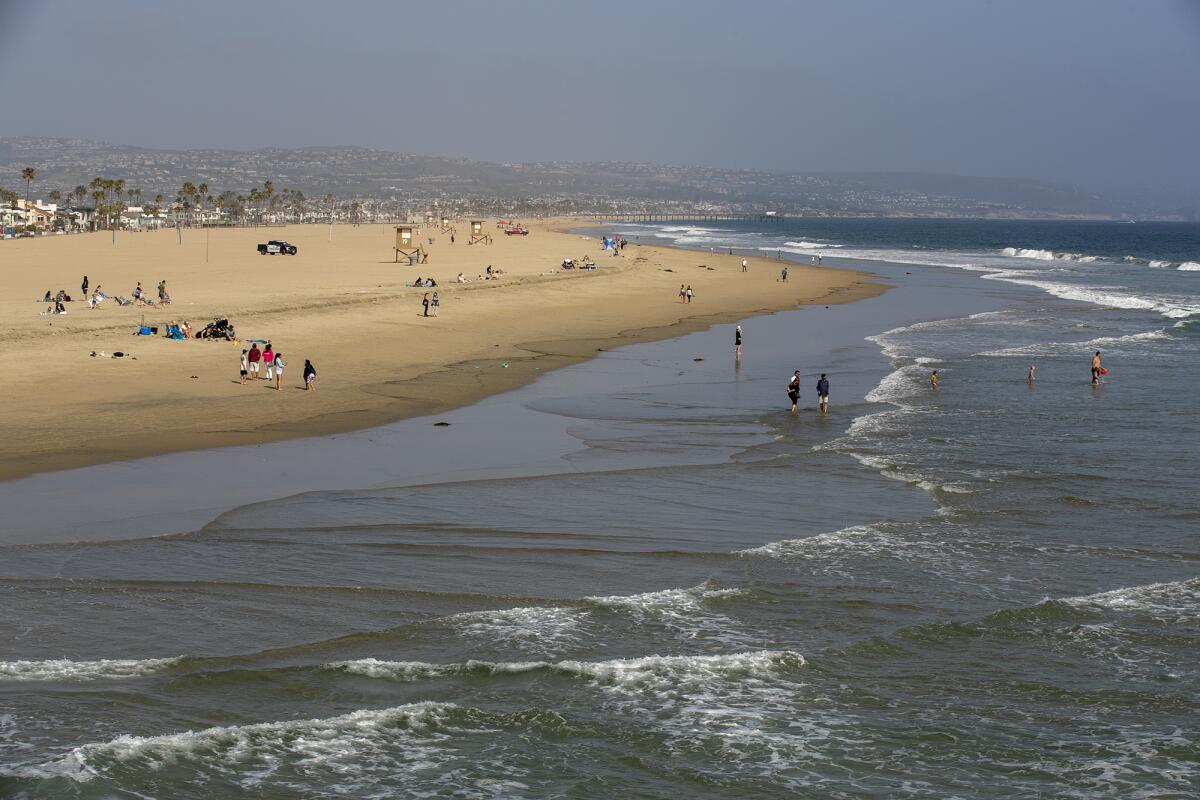Wildlife experts fear seabird deaths as red tide washes up near Newport Pier

- Share via
An algal bloom, also known as red tide for the coloration the water sometimes takes on, washed into the area near Newport Pier on Monday, worrying wildlife experts who fear it will cause feather fouling in local seabirds.
Such blooms occur when algae grows out of control due to nutrient-rich environments and favorable water and wind conditions, according to the National Oceanic and Atmospheric Administration.
OC Coastkeeper marine restoration director Claire Arre said algal blooms tend to happen between early spring and late summer but don’t occur annually.
It’s hard to even call them seasonal, Arre said.
The Centers for Disease Control note that not all algae produces toxins and not all blooms are considered harmful, but the algal bloom near Newport Pier was identified by experts as Akashiwo sanguinea, historically associated with “harmful algae blooms.” The species was one of the dominant players in the deaths of a significant number of Monterey Bay’s marine fowl population in 2007.
“Different algae have different potentials to cause harm,” said Arre, who has been monitoring the situation. “The biggest concern with this algae is the fouling of birds, which is essentially [the algae bloom] removing the oil from a bird’s feathers, making it so that the birds are no longer waterproof or insulated, which in our cold waters can make them hypothermic and kill them.”
Officials at the Wetlands and Wildlife Care Center in Huntington Beach said birds affected by the red tide will appear wet.
“After contact with this species of algal bloom, the seabirds’ feather integrity is broken, allowing water to seep to their skin and causing them to become hypothermic,” said Wetlands and Wildlife Care Center executive director Debbie McGuire. “The birds then beach themselves and look waterlogged. If seen in this condition, they need to be transported into care.”
McGuire said as of Wednesday afternoon the center hasn’t seen many sea birds affected by the red tide entering its care , but the center remains on alert should that change. If beachgoers witness larger animals like seals or sea lions in distress, Arre advises them to call the Pacific Marine Mammal Center in Laguna Beach.
“It’s scary,” Arre said of the Akashiwo sanguinea. “In Monterey Bay, they had a huge bloom, and it killed thousands of birds. They were just washing up in the waves.”
While this specific species hasn’t been historically linked to causing human harm, Arre advised beachgoers to avoid entering water that appears to have a red or orange tint.
“If you see a red tide, don’t enter it. If you consume any of the water, it could give you [gastrointestinal] issues. You’d have to consume a lot of water for it to really hurt you, but it could ruin the next 24 hours for you if you surf in it,” Arre said.
The algal bloom in Newport Beach is moderately sized and not as large as the bloom that occurred in Monterey Bay. Still, Arre said it is possible that the bloom could grow if conditions remain favorable. It is uncertain when this particular bloom will die off.
All the latest on Orange County from Orange County.
Get our free TimesOC newsletter.
You may occasionally receive promotional content from the Daily Pilot.




